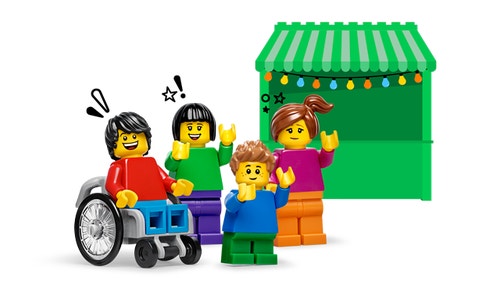SPIKE™ Essential
Creative Carnival Games
It’s time to create a new game for the school carnival!
45-90 min.
Beginner
Years 3-5

Prepare
NOTE: This lesson will extend over two 45-minute class sessions.
- Review the Creative Carnival Games lesson in the LEGO® Education SPIKE™ App.
- Consider the abilities and backgrounds of all your pupils. Differentiate the lesson to make it accessible to everyone. Please refer to the Differentiation section below for suggestions on how to do this.
- If time permits, plan and facilitate the language arts extension. Please refer to the Extension section below for further information.
PART A (45 Minutes)
Engage
(Whole Class, 10 Minutes)
- Facilitate a quick discussion about designing a new game for a school carnival.
- Talk with your pupils about creating a game that shows energy transfer.
- Ask questions like these: What types of games show energy transfer? What does the energy transfer look like?
- Introduce your pupils to the team and the challenge: brainstorming a new carnival.
- Distribute a brick set, any additional brainstorming materials and a device to each group.
Explore
(Small Groups, 25 Minutes)
- Have your pupils use the LEGO® Education SPIKE™ App to guide them through their first challenge:
- Create a new carnival game. Use at least one motor or sensor (e.g. Colour Sensor)
- Your pupils can brainstorm using the LEGO bricks supplemented with additional materials. Encourage them to think of multiple solutions.
Explain
(Whole Class, 10 Minutes)
- Facilitate a sharing session in which your pupils present their initial ideas and provide feedback and suggestions to their peers.
PART B (45 Minutes)
Elaborate
(Small Groups, 30 Minutes)
- Have your pupils build, program and test the prototypes and ideas that they came up with during the brainstorming session in Part A of this lesson.
- Remind them to use at least one motor or sensor.
- Encourage them to test and refine their models and programs over 2-3 iterations.
- You can find coding and building help in the Tips section below.
Evaluate
(Whole Class, 15 Minutes)
- Ask guiding questions to encourage your pupils to ‘think aloud’ and explain their thought processes and reasoning in the decisions they’ve made while building and programming their models.
- Have your pupils tidy up their workstations.
Observation Checklist
- Measure your pupils’ proficiency in applying their existing knowledge of energy transfer and collision as they complete the given task.
- Establish a scale that suits your needs. For example:
- Requires additional support
- Can work independently
- Can teach others
Self-Assessment
Have each pupil choose the brick that they feel best represents their performance.
- Yellow: I think that I can design, build and program a solution.
- Blue: I can design, build and program a solution.
- Green: I can design, build and program a solution, and I can also
help a friend to do it.
Peer Feedback
- In their small groups, have your pupils discuss their experiences of working together.
- Encourage them to use statements like these:
- I liked it when you…
- I'd like to hear more about how you…
Tips
Coding Tips
- There are no coding instructions or Inspiration Coding Blocks for this lesson.
- Encourage your pupils to experiment and find their own solutions.
Model Tip
- There are no building instructions or Inspiration Images for this lesson.
- Encourage your pupils to create their own models.
- If they require further guidance, refer them to the building instructions for the previous lessons in this unit.
- There is no right or wrong model for this lesson.
- Your pupils can create entirely new models, find inspiration in the models from the previous lessons or simply recreate models from earlier lessons.
Differentiation
Simplify this lesson by:
- Working together as a class to brainstorm new ideas for a game
- Giving your pupils the building instructions from the previous lessons to use as inspiration for their new carnival games
Increase the difficulty by:
- Using two motors or sensors
- Creating two unique programs so that the game has a simple version and a more difficult one
Extension
- Have your pupils write descriptions of their carnival games, clearly stating where the transfer of energy occurs, how it occurs and how collision affects the game.
If facilitated, this will extend beyond the 90-minute lesson.
Language Arts: National Curriculum English En4/3.3 Composition b
Teacher Support
The pupils will:
- Apply their existing scientific knowledge of energy transfer and collision to solving a problem
- Engage effectively in a range of collaborative discussions
(one for every two pupils)
- LEGO® Education SPIKETM Essential Set
- Device with the LEGO® Education SPIKE™ App installed
- OPTIONAL: Additional materials for brainstorming (e.g. notebook paper, science notebook, etc.)
National Curriculum
Science
Sc5/4.2b
- identify the effects of air resistance, water resistance and friction, that act between moving surfaces
English
En4/1i
- participate in discussions, presentations, performances, roleplay/improvisations and debates
En4/1k - consider and evaluate different viewpoints, attending to and building on the contributions of others
En4/3.3b
Draft and write by: - composing and rehearsing sentences orally (including dialogue), progressively building a varied and rich vocabulary and an increasing range of sentence structures
- organising paragraphs around a theme
- in narratives, creating settings, characters and plot
- in non-narrative material, using simple organisational devices




